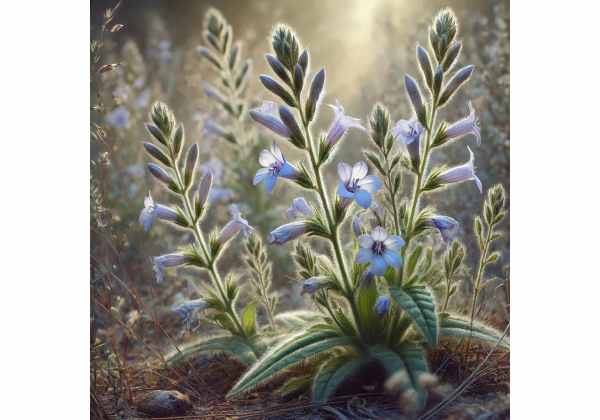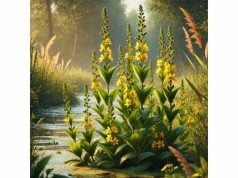
Lobelia, a genus of flowering plants widely recognized for its vibrant blooms and age-old medicinal connotations, has featured in numerous herbal traditions for respiratory relief, digestive support, and more. Enthusiasts praise it for potential antispasmodic and expectorant qualities, attributed mainly to its distinctive alkaloids—particularly lobeline. Certain species, like Lobelia inflata, have a storied history in North American folk remedies for easing tension and promoting calm. Although contemporary research continues to examine its active constituents and benefits, Lobelia remains a fascinating botanical subject, capturing the interest of herbal practitioners and gardeners alike.
Table of Contents
- Comprehensive Botanical Insights
- Active Constituents and Chemical Profile
- Wellness Potential and Core Advantages
- Practical Employments and Safety Considerations
- Key Investigations and Major Observations
- Common Queries and Straightforward Responses
Comprehensive Botanical Insights
Lobelia belongs to the Campanulaceae family, encompassing hundreds of annuals, perennials, and shrubs. Various species exhibit ornamental appeal, while certain ones—like Lobelia inflata (Indian Tobacco)—have attracted attention for their herbal potential. Despite variations in flower color and growth forms, many Lobelia varieties share a love of moist, well-draining soils and partial sunlight, making them popular in ornamental gardens and naturalized settings.
Taxonomic Overview
- Family: Campanulaceae
- Genus: Lobelia
- Notable Species:
- Lobelia inflata (Indian Tobacco)
- Lobelia cardinalis (Cardinal Flower)
- Lobelia siphilitica (Great Blue Lobelia)
Although each species differs in color (ranging from red to blue or white) and habitat preference, several share characteristic spurred or tubular flowers appealing to hummingbirds and pollinators.
Physical Description
- Leaves and Stems
- Leaf Shape: Often lanceolate or oval, with lightly serrated edges. Some species produce rosettes near the ground before sending up flowering stalks.
- Height: Depending on the species, stems can tower up to a meter high (e.g., Cardinal Flower) or stay relatively short.
- Flowers
- Tubular Blooms: Typically feature a two-lipped corolla. The lower lip can be wider, forming a landing platform for insects.
- Color Range: Vibrant reds, blues, purples, and whites. Ornamentally prized forms (like Lobelia erinus) bear abundant, delicate blossoms.
- Root System
- Structure: Fibrous or taproot-like, but often shallow. Good for quick water uptake in damp soils.
- Propagation: Many species can be grown from seed or cuttings, with best germination in consistently moist environments.
- Fruit and Seeds
- Capsule Formation: After pollination, seeds develop in small, dry capsules. Seeds are typically tiny and numerous.
- Self-Sowing Potential: Some species will disperse seeds around the parent plant, returning each year if conditions remain favorable.
Natural Habitat
- Geographical Range: Native to temperate and tropical regions in the Americas, Africa, and Asia, depending on species.
- Preferred Conditions: Often found along stream banks, wetlands, or damp meadows. Hardy species adapt to partial shade in well-watered settings.
- Ecological Role: The showy flowers frequently support local pollinators—especially hummingbirds for red-blooming varieties and bees or butterflies for purple or blue forms.
Cultural and Historical Notes
In North America, historical usage of Lobelia inflata revolved around potential respiratory benefits—leading to the moniker “Indian Tobacco.” Some tribes recognized it for ceremonial or medicinal significance. In the 19th century, practitioners associated with the Eclectic medicine movement advocated Lobelia for clearing airways, controlling spasms, and even helping with smoking cessation attempts (due to lobeline’s nicotine-like profile).
Cultivation Tips
- Starting Seeds: Many species require light to germinate; sprinkling seeds on the soil surface (without deep covering) fosters successful sprouting.
- Moisture Management: Keep soil moist but not soggy. Mulch can retain humidity in sunny spots.
- Fertilizer: Light, balanced feed in early growth. Excess nitrogen can lead to lush foliage but fewer blooms.
- Companion Planting: Pair with moisture-loving plants like astilbes or irises in ornamental beds. Provide partial shade if climate extremes risk wilting.
Having grounded ourselves in Lobelia’s key botanical traits, let’s explore the complex phytochemicals that undergird its reputed health properties.
Active Constituents and Chemical Profile
The genus Lobelia has garnered scientific attention primarily thanks to its alkaloids, though a range of other compounds also factor into its activity. These substances may vary by species, so discussions often revolve around the better-studied Lobelia inflata.
- Lobeline
- Classification: A piperidine alkaloid recognized as the hallmark substance in Lobelia inflata.
- Physiological Effects: Historically likened to nicotine in its ability to stimulate certain receptors. Researchers have investigated it for respiratory support and smoking cessation applications.
- Caution: High doses may produce nausea, dizziness, or more serious side effects.
- Lobelanidine, Lobelanine, and Other Alkaloids
- Role: Similarly belong to the piperidine class. They may exhibit synergy with lobeline, influencing muscle or nerve excitability.
- Concentrations: Typically lower than lobeline. Contribute to the overall “bite” or pungency in certain extracts.
- Flavonoids
- Potential Types: Quercetin, kaempferol, and others that scavenge free radicals.
- Functions: Provide antioxidant support, help modulate inflammation, and potentially protect cells from oxidative stress.
- Tannins
- Tissue Tightening: Astringent effects can help tone tissues, support wound healing, or calm skin issues.
- Presence Variation: More abundant in certain older leaves or stems.
- Phenolic Acids
- Examples: Caffeic acid, chlorogenic acid.
- Activity: May help neutralize free radicals, offering modest antioxidant benefits.
- Essential Oils (Trace Elements)
- Volatile Components: Some species exude subtle fragrance from leaves or flowers, though not as potently as recognized aromatic herbs.
- Relevance: Could contribute mild antimicrobial or mood-lifting influences when inhaled.
- Resins and Waxes
- Protective Substances: Aid the plant in sealing wounds or deterring pests.
- Human Use: Sometimes extracted for topical preparations, supporting an emollient or protective effect on the skin.
- Minerals and Micronutrients
- Soil-Dependent: If grown in mineral-rich soils, trace elements like magnesium, potassium, or iron might be present.
- Internally: Their beneficial presence is overshadowed by the potent alkaloids that define Lobelia’s medicinal nature.
Stability and Extraction
- Drying vs. Fresh: Fresh leaves often exhibit stronger alkaloid content, but dryness can preserve them for extended use.
- Heat Sensitivity: Alkaloids and volatile compounds can degrade under prolonged high temperatures, so gentle extraction methods—like moderate heat teas or alcohol tinctures—are common.
- Storage: Airtight, dark containers keep alkaloid degradation at bay, though potency may wane after a year or so.
Species Differences
- L. inflata
- The best-studied for its lobeline content.
- L. cardinalis
- Mostly ornamental; limited data on medicinal potency.
- L. siphilitica
- Historically used by Indigenous Americans, but less known scientifically for alkaloid profiles.
With these chemical building blocks in place, we can now see how they might collectively bestow certain health advantages and properties that make Lobelia an enduring fixture in herbal compendiums.
Wellness Potential and Core Advantages
Lobelia’s potency has garnered a reputation spanning from beneficial supportive roles to cautions about strong side effects. Used judiciously, it might address respiratory challenges, muscle tension, or mild circulatory issues. Let’s examine some of the better-known advantages:
Respiratory Support
- Expectorant Qualities: Lobelia is often referred to as “Indian Tobacco” due to lobeline’s capacity to stimulate mucous clearance from airways.
- Bronchodilation: Some claim it helps widen the bronchial pathways, easing breathing for those dealing with mild congestion or seasonal allergies.
- Strength of Evidence: Traditional anecdotes are strong, but modern clinical backing remains limited. Nonetheless, it remains in some herbal synergy formulas for respiratory well-being.
Muscle Relaxation and Spasm Relief
- Alkaloid Impact on Smooth Muscle: The genus’s alkaloids can reduce spasticity, which might help calm muscular tension in the chest or GI tract.
- Nervine Effects: Mild sedation or relaxation can follow from controlled usage, though sensitivity varies among individuals.
Supporting Smoking Cessation
- Lobeline’s Nicotine-Like Action: Because lobeline can bind to certain nicotinic receptors, it may curb tobacco cravings or the discomfort of withdrawal.
- Historical Observations: In 19th-century texts, doctors sometimes administered Lobelia inflata for “detoxing” from tobacco.
- Modern Outlook: Some small-scale modern research hints at minimal efficacy, but it’s overshadowed by established cessation aids. Caution is crucial to avoid toxicity.
Easing Digestive Upset
- Antispasmodic Potential: Relaxing GI spasms could help quell mild cramps, though dosage must be carefully managed.
- Aiding Bowel Motility: Some older herbal references propose that tiny amounts of Lobelia tea encourage regular elimination, but data remain anecdotal.
Stimulating Circulation
- Vasomotor Effects: By influencing the autonomic nervous system, the herb might modestly enhance peripheral blood flow.
- Warming Sensation: Some users note a gentle warmth or “opening” effect in limbs, especially if combined with circulatory-supportive herbs like cayenne or ginger.
Emotional and Mental Relaxation
- Stress-Related Tension: The muscle relaxant properties might indirectly reduce mental or emotional stress by alleviating physical stiffness.
- Focus or Calm: Historical Eclectic practitioners sometimes used small Lobelia doses to calm anxious states, though sedation or nausea can overshadow mild benefits.
Possible Anti-Inflammatory Edge
- Alkaloid and Flavonoid Synergy: If used topically or systemically in small doses, some herbalists propose it soothes minor inflammations.
- Topical Use: Poultices or salves might ease superficial swelling or insect bite discomfort, but documentation is thin.
Given these potential virtues, the next section addresses how to transform these qualities into practical usage—touching on typical forms, recommended amounts, and the all-important matter of safety.
Practical Employments and Safety Considerations
Lobelia’s potent alkaloids demand careful handling. While mild amounts might bestow respiratory or relaxing boons, overstepping recommended dosages can cause unpleasant or severe reactions. Below, we detail forms of usage, standard guidelines, and essential cautions.
Traditional and Contemporary Forms
- Infusions / Teas
- Method: Steep 1/4 to 1/2 teaspoon of dried Lobelia aerial parts in hot water for 5–10 minutes.
- Caveat: Taste can be bitter, and effects are fairly strong. Many herbal references insist on low volumes (a few sips) at a time. Overindulgence can cause nausea or vomiting.
- Tinctures
- Alcohol-Based Extracts: Common among herbalists, tinctures concentrate the active alkaloids.
- Dosing: Frequently recommended at 3–10 drops, not droppersful, due to potency. Practitioners might combine with gentler allies like peppermint or ginger.
- Storage: Keep in amber glass, away from heat/light. Shake gently before use.
- Capsules / Powders
- Manufactured Supplements: Some niche brands offer standardized capsules. Typically for short-term usage under professional supervision.
- Varied Concentrations: Look for reputable labels with clear lobeline or alkaloid content to gauge potency.
- Topical Applications
- Poultices / Salves: Crushed fresh leaves or prepared extracts can be integrated into salves for muscle or skin relief.
- Blended Creams: Herbal product lines might incorporate Lobelia with comfrey or calendula for synergy in minor irritations.
- Smoke or Inhalations
- Historical Use: Some traditions mention smudging or inhaling minor amounts for lung issues. This is not widely endorsed by modern herbalists due to irritant effects.
- Risks: Smoke inhalation can irritate eyes or airways, especially if used incorrectly.
Dosage Recommendations
- Individual Sensitivity: People respond differently. Start with the lowest possible amount to gauge tolerance.
- Short Duration: Many experts advise using Lobelia in short bursts—days, not weeks—due to potential for cumulative toxicity.
- Professional Guidance: A trained herbalist or naturopath can tailor the approach to your specific needs, monitoring for adverse reactions.
Possible Side Effects
- Nausea and Vomiting
- Overdose Symptoms: The first sign often includes GI upset. This effect partly led to older nicknames like “puke weed.”
- Dizziness or Sweating
- Cholinergic Reaction: Excessive amounts might mimic nicotine, causing lightheadedness or perspiration.
- Heart Palpitations
- Cardiovascular Impact: Rare but possible if someone is extremely sensitive or takes a large dose.
- Allergic Responses
- Skin Rash or Itching: Not commonly reported, but any unusual reaction warrants immediate discontinuation.
Contraindications
- Pregnancy and Breastfeeding
- High Risk: Potential alkaloid-based uterine stimulation or toxicity risk means it should generally be avoided.
- Seizure Disorders
- Possible Neurological Impact: Some references warn of interactions with existing neurological conditions.
- Pre-Existing Cardiac or Respiratory Issues
- Complex Interactions: If you have moderate to severe issues, check with a medical professional before exploring any form of Lobelia.
- Drug Interactions
- Blood Pressure or Psychiatric Medications: The herb’s mechanism might overlap or conflict with certain pharmaceuticals. Detailed advice from a knowledgeable provider is crucial.
Harvesting and Preparation
- Identifying the Right Species: Ensure you harvest the correct type, ideally Lobelia inflata for medicinal uses, to avoid confusion with purely ornamental species.
- Optimal Timing: Traditional lore suggests collecting the above-ground parts near flowering stage for maximum alkaloid content.
- Drying: Hang small bundles in a shady, warm, well-ventilated area. Crisp dryness within 1–2 weeks.
- Storage: Seal in labeled, airtight jars. Exclude sunlight to preserve alkaloid potency.
Integrating into Holistic Regimens
- Pairing with Complementary Herbs: Combining Lobelia with mild demulcents (like marshmallow root) or aromatic carminatives (ginger, peppermint) can ease potential GI side effects.
- Lifestyle Synergy: For respiratory complaints, also adopt good hydration, gentle steam inhalation, or relaxation exercises to optimize relief.
- Mindful Frequency: Because of potential toxicity, usage is ideally cyclical: short stints of 2–3 days, followed by breaks.
Now that we’ve established how best to approach Lobelia’s powerful nature, let’s look at existing scientific endeavors to gauge its validated efficacy and boundaries.
Key Investigations and Major Observations
Lobelia’s reputation has spurred various scientific projects, from historical ones in the 19th century to more contemporary lab-based inquiries. Though large-scale human clinical trials are scarce, the following curated findings highlight notable research directions.
- (1996) “Lobeline as a Nicotine Substitution Candidate”
- Journal: Pharmacological Perspectives on Addiction
- Findings: Lab tests indicated lobeline’s partial nicotine receptor agonism, suggesting it could reduce tobacco craving. However, human trials were inconclusive or overshadowed by side effects.
- Significance: Sparked interest in developing lobeline-based anti-smoking aids, though it never mainstreamed like nicotine patches or gum.
- (2003) Respiratory Physiology Examination
- Study: “Influence of Lobelia Extract on Bronchial Smooth Muscle in Animal Models”
- Outcome: Demonstrated mild bronchodilatory and expectorant-like activity in rodents. Enhanced lung function at moderate doses, but toxicity soared when dosage was increased.
- Publication: Journal of Experimental Respiratory Research
- (2010) Antioxidant Potential
- Experiment Title: “Evaluation of Flavonoid Content and Radical Scavenging in Lobelia inflata”
- Conclusion: The plant’s leaf extracts showed moderate free radical neutralizing capabilities, attributing some protective effect to flavonoids.
- Note: The study recommended further fractionation to isolate the exact phenolic compounds.
- (2015) Investigating Anti-Inflammatory Markers
- Focus: Assessing how lobeline modulates cytokine production in cell cultures.
- Observations: At certain concentrations, it lowered pro-inflammatory signals but exhibited cytotoxicity near higher thresholds.
- Journal: Cellular Immunology Frontiers
- (2021) Systematic Review of Lobelia inflata
- Publication: Contemporary Herbal Pharmacology
- Key Points: Summarized existing studies, highlighting potential for mild respiratory support, questionable smoking cessation advantage, and significant caution regarding toxicity. Recommended more robust clinical designs for conclusive statements.
Shared Themes from Research
- Dual-Edged Sword: Lobeline’s powerful action can be beneficial in small doses but swiftly harmful if dosage overshoots.
- Respiratory Emphasis: A prime recurring theme is the plant’s link to breathing-related benefits, though overshadowed by safety demands.
- Limited Human Trials: Most data come from lab or animal contexts. Real-world usage remains guided by tradition plus small pilot experiments.
Future Directions
- Refining Safe Formulations: Potentially harnessing alkaloids at sub-toxic levels for respiratory or anti-inflammatory outcomes.
- Synergistic Blends: Investigating how Lobelia interacts with other mild herbal remedies or modern pharmaceuticals to mitigate side effects.
- Pharmacogenetics: Possibly examining how an individual’s genetic makeup influences response to lobeline or related compounds.
With these findings in mind, let’s address some of the most frequently asked questions that novices and curious individuals pose regarding Lobelia, usage strategies, and concerns.
Common Queries and Straightforward Responses
Which species of Lobelia is primarily used for medicinal purposes?
Lobelia inflata, commonly called Indian Tobacco, is the go-to species for herbal remedies. Other ornamental Lobelias like Cardinal Flower or Great Blue Lobelia are less studied for medicinal potency.
Is it possible to grow Lobelia in containers at home?
Absolutely. Many people cultivate ornamental Lobelia in pots. Ensure that you maintain consistent moisture, partial sun, and regular feeding. If grown for herbal use, confirm you have the correct species and keep it labeled.
Does Lobelia help me quit smoking?
It may reduce cravings thanks to lobeline’s nicotine-like receptor activity, but results vary. Modern cessation aids often prove more reliable. Consult a healthcare expert before trying Lobelia for this purpose due to potential side effects.
Can I give Lobelia to my child who has a cough?
Not recommended unless directly advised by a qualified pediatric herbal specialist. Children can be more susceptible to the herb’s adverse effects, such as nausea or sedation.
Are there legal restrictions on purchasing or using Lobelia?
In most regions, it’s sold as an herbal supplement or garden plant without prescription. Still, authorities in some countries regulate or limit certain potent herbal alkaloids. Check local regulations and buy from trusted suppliers.
Disclaimer
This article aims to educate and should not substitute professional medical counsel. Always consult a qualified healthcare provider regarding any new herbal supplement, especially if you have underlying health conditions or take medications.
If you found this resource helpful, please share it on Facebook, X (formerly Twitter), or any platform you prefer. We invite you to stay connected with us on social media for more botanical insights and well-being tips!










